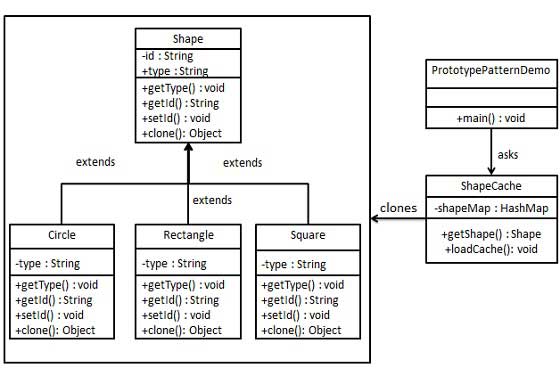原型模式是指在考虑性能的同时创建重复对象。 这种类型的设计模式属于创建模式,因为这种模式提供了创建对象的最佳方法之一。
该模式涉及实现一个原型接口,该接口告诉创建当前对象的克隆。 当直接创建对象成本高昂时使用此模式。 例如,一个对象将在一个代价高昂的数据库操作之后创建。 我们可以缓存对象,在下一次请求时返回其克隆,并在需要时更新数据库,从而减少数据库调用。
说明
我们将创建一个抽象类 Shape 和扩展 Shape 类的具体类。 一个类 ShapeCache 被定义为下一步,它将形状对象存储在 Hashtable 中,并在请求时返回它们的克隆。
PrototypPatternDemo,我们的演示类将使用ShapeCache类来获取一个Shape对象。

第一步
创建一个实现 Cloneable 接口的抽象类。
Shape.java
public abstract class Shape implements Cloneable {
private String id;
protected String type;
abstract void draw();
public String getType(){
return type;
}
public String getId() {
return id;
}
public void setId(String id) {
this.id = id;
}
public Object clone() {
Object clone = null;
try {
clone = super.clone();
} catch (CloneNotSupportedException e) {
e.printStackTrace();
}
return clone;
}
}第二步
创建实现类
public class Rectangle extends Shape {
public Rectangle(){
type = "Rectangle";
}
@Override
public void draw() {
System.out.println("Inside Rectangle::draw() method.");
}
}
public class Square extends Shape {
public Square(){
type = "Square";
}
@Override
public void draw() {
System.out.println("Inside Square::draw() method.");
}
}public class Circle extends Shape {
public Circle(){
type = "Circle";
}
@Override
public void draw() {
System.out.println("Inside Circle::draw() method.");
}
}第三步
创建一个使用类
import java.util.Hashtable;
public class ShapeCache {
private static Hashtable<String, Shape> shapeMap = new Hashtable<String, Shape>();
public static Shape getShape(String shapeId) {
Shape cachedShape = shapeMap.get(shapeId);
return (Shape) cachedShape.clone();
}
// for each shape run database query and create shape
// shapeMap.put(shapeKey, shape);
// for example, we are adding three shapes
public static void loadCache() {
Circle circle = new Circle();
circle.setId("1");
shapeMap.put(circle.getId(),circle);
Square square = new Square();
square.setId("2");
shapeMap.put(square.getId(),square);
Rectangle rectangle = new Rectangle();
rectangle.setId("3");
shapeMap.put(rectangle.getId(), rectangle);
}
}第四步
演示原型的使用方式
public class PrototypePatternDemo {
public static void main(String[] args) {
ShapeCache.loadCache();
Shape clonedShape = (Shape) ShapeCache.getShape("1");
System.out.println("Shape : " + clonedShape.getType());
Shape clonedShape2 = (Shape) ShapeCache.getShape("2");
System.out.println("Shape : " + clonedShape2.getType());
Shape clonedShape3 = (Shape) ShapeCache.getShape("3");
System.out.println("Shape : " + clonedShape3.getType());
}
}总结
原型模式最大的特点就是复用,减少无用的new操作
Pingback: 设计模式-单例模式 – 微爱博客